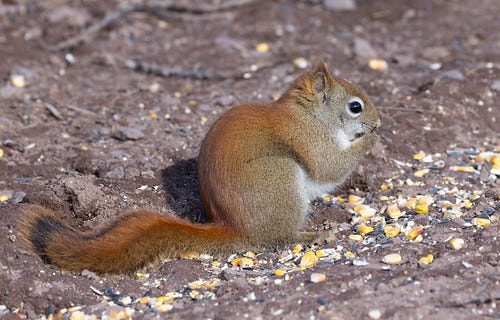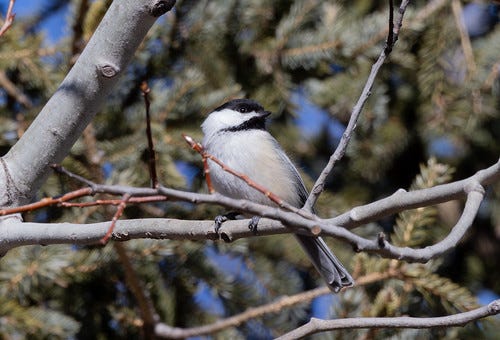(Listen to the radio version here.)

In November 1991, for one brief, shining moment—well, a moment that lasted eight days—a Fieldfare hung around Devil’s Track River near Highway 61 in Grand Marais, Minnesota. That’s when my children were little and, tragically for me, happened right when Russ had to travel for a work-related meeting out of state, so I could not break away in time to see this robin-sized thrush that belongs in Eurasia.
Fieldfares are handsome thrushes in the genus Turdus with our American Robin. Their cool gray head and lower back contrast strikingly with their warm brown wings, and their soft rusty breast and sides are speckled like a young robin.
Fieldfares are quite common in Scandinavia and northern Europe through Siberia during the breeding season, working their way south to the UK and southern Europe as far as coastal northern Africa in winter.

Some individual Fieldfares apparently have an abysmal sense of direction, and once in a very rare while, a vagrant turns up in Canada or, even more rarely, in one of the northern states. The American Birding Association calls this a Code 4 bird—a species not reported every year in the ABA Checklist Area but with six or more total records, including at least three in the past 30 years, reflecting at least a little likelihood that one will turn up somewhere on the continent again eventually.
Back on November 12, 1991, I did manage to get away to Grand Marais, missing the mega-rarity by two days but in time to see another odd vagrant: the first Anna’s Hummingbird ever documented in Minnesota, which had been reported the day before. So that trip wasn’t an entire bust. Three more Anna’s Hummingbirds have turned up in Minnesota in the following decades, but the 1991 Grand Marais Fieldfare remains the only record of the species in Minnesota or anywhere else in the Midwest, or at least it was until just last week. On Thursday, February 15, one turned up in Prentice Park in Ashland, Wisconsin, seen and photographed by Tim Oksiuta.
A bird this exceptionally rare would not show up as a possibility in the Merlin app and, because not one had ever been seen in the state before, it wasn’t on the eBird checklist for Wisconsin, so it was tricky to identify. At first glance, it blended in with the backlit Blue Jays it was hanging out with, being the same size and perched in the midst of the group. If Tim hadn’t noticed its more thrushlike flight, the bird probably would have been overlooked entirely.
Most birders didn’t hear about it until Friday, but no one located it again until Sunday morning, when Tim Oksiuta refound it and instantly got the word out. Within minutes, Nick and Charlie Anich, Rowan Gibson, Adri Losey, Wyatt Isakson, and Gracelin Crabbs arrived and got to see it, too. Erik Bruhnke and I made the 72-mile trip as soon as we could, and throughout the day about 25 birders joined the search, but apparently all the sightings were over well before 10 am. Both times it was seen, the Fieldfare was associating with a flock of somewhere between 8 and 15 Blue Jays and a single Common Grackle—a flock that had gone somewhere else by the time most of us arrived. Erik and I did see three Blue Jays but could not locate the larger flock.
In their proper range, Fieldfares are extremely sociable in winter, so with no other Fieldfares within thousands of miles, it doesn’t surprise me that this one was hanging out with another species. I’d have expected it to join a robin flock, but those are few and far between this year. There are still plenty of berries here and there, but with the freakishly warm winter we’ve had, I suspect that a lot of the remaining berries are fermenting dangerously.
The Fieldfare’s winter diet includes fruits, seeds, and whatever insects, earthworms, and other invertebrates it can find. Its normal habitat year-round contains large trees for breeding and roosting, and smaller fruiting trees, hedges, and expanses of open ground for foraging. The area in Prentice Park where this one has been seen seems exactly right. I suspect that lots of birders will be spending their early mornings in Ashland this week, listening for the blackbird-like chatter notes of the Fieldfare and checking out every Blue Jay they can find.
I’m glad Erik and I looked for it—we knew we had a very low probability of seeing it, but we also knew we’d have zero chance if we didn’t at least try. Unlike my 1991 Grand Marais adventure, we didn’t get the consolation prize of a different first state record, but did see lots of chickadees, two White-breasted Nuthatches, an adorable red squirrel pigging out on cracked corn, a Pileated Woodpecker yelling his fool head off at close range, and plenty of other birders we could catch up with.
It would have been thrilling to see that Fieldfare—a lifer!—but even without it, we had lots of fun. And like the best birding days, our wild goose chase left me with a good story, this one about the one that got away.







We were fortunate to visit Scandinavia in June 2022 and saw lots of Fieldfares. :-) Sorry you missed it!
As the fishing people say, "the worst day birding (insert your favorite activity here) is better than the best day working!